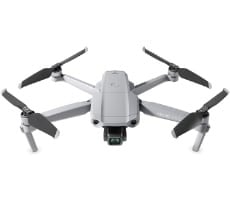DJI Mavic Air Drone Review: A Compact, Powerful Eye In The Sky
My initial flight left me utterly impressed as I experimented with the Air at a distance of roughly 1800 feet. Once I became more comfortable flying the drone, I chose to take it to some greater heights, and explore some more interesting landscapes. The Air proved that in even strong winds, it was capable of holding its ground and correcting for almost all variables. I found that with a clean compass calibration, the aircraft was able to hover in place without much movement at all, in moderate wind and at relatively high altitudes.
The only thing more impressive than the stability of the drone during flight is the smoothness of the media recorded while flying. One drawback that I noticed while flying may or may not bother some users, however. Compared to the Mavic Pro or Mavic Pro Platinum, the Mavic Air is quite noisy during flight. The drone can still be clearly heard on most days at an altitude of 300 feet. This tends to attract even more attention when flying around others, something that most pilots want to avoid.
For the most part during flight, the connection was strong and clear between the drone and my mobile device. There were no issues reaching DJI’s maximum rated distances and altitudes while flying the Air in rural areas. When flying in more densely populated areas (not advised), such as around buildings or near larger structures, we tended to run into some interference issues. While I have not personally owned a Mavic Pro, and cannot make a direct comparison between the two slightly different communication protocols of each drone, I can conclude that the range and signal strength of the Mavic Air's system was more than adequate for my photography needs.
The truth of the matter is, drones can be a hazard when flown around others, and nobody wants to lose their $800 device or worst yet, hurt someone. So if the Air is flown in a manor that does not push the pilot's or drone's limits, there is a very small chance that communication and interference issues will cause any real trouble. One lesson I learned quickly, was the importance of launching away from running vehicles. While flying around large metal structures wasn’t nearly as problematic as it could seem, for whatever reason -- most likely EMI from the alternator -- the Air did not perform well when launched near a running motor.
During flight, I found that the pre-programmed take-off / landing functions, in addition to the quick shot modes, performed flawlessly when in a suitable environment. The DJI app works exceptionally well with its built-in safeguards, whether or not the pre-programmed functions can be performed. Additionally, the on-board sensors performed perfectly in field testing. I found that solid structures were easily recognizable by the sensors, and even mesh fence and similar materials were not a problem. While ideally a pilot is able to fly the aircraft back to the initial launch site, I found that the return to home functions were reliable, assuming a proper GPS signal and compass calibration were in place.
One gripe that many Air owners have had with the drove was the decreased flight time. DJI sent us the “fly more package”, however, which came with three batteries, so we did not run into the same frustrations. With an average flight time of 20-21 mins though, I found that one battery was sufficient for capturing one specific landscape. As a budding photographer, I can understand the need for more than one battery though, because 20 mins of flight time simply wouldn’t be enough for a full work day of footage. I suspect that for the average hobbyist, however, having a minimum of three batteries would probably be sufficient. We should also note that the four bank battery charger included with the kit charges all of the batteries remarkably fast -- somewhere in the neighborhood of 50 minutes to an hour.











